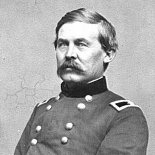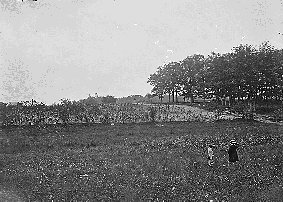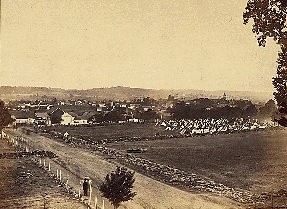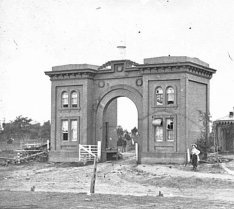The Battle of Gettysburg: Day
1
 |
At 8
A.M., John Buford’s scouts reported Heth’s advance on Cashtown road. Although
the Buford’s Union forces were outnumbered, they were equipped with Spencer repeating
Carbines which gave them a five-to-one firepower superiority. The dismounted Union cavalry
fought the large number of advancing Confederate forces, stubbornly holding on to
McPherson’s Ridge. |
| After two long hours, the Union First Corps
arrived with General Reynolds. Reynolds sent messengers to Meade telling him of the large
enemy force. As part of the First Corps reinforcements were the proud First Brigade of the
First Division of the First Corps, Meridith’s Iron Brigade; along with Cutler’s
Second Brigade of well disciplined Pennsylvania and New York regiments. Reynolds replaced
Buford’s weary cavalry with Cutler’s brigade on the right and Meridith’s
brigade on the left. While General Reynolds was directing an attack, he was shot behind
the ear by a Confederate sharp-shooter. He gasped once, smiled-and died. Second-in-command
to Reynolds, General Doubleday assumed command of the Union forces. |
 |
Heth believed the Union forces were at a
breaking point and sent two brigades under Davis and Archer toward McPherson’s Ridge.
Doubleday counter attacked with the Iron Brigade and drove the Archer’s forces back.
A private named Patrick Maloney captured General Archer as the Confederate forces were
retreating. General Doubleday exclaimed “Archer! I’m glad to see you!”
General Archer replied “Well, I’m not glad to see you by a damn sight.”
Davis’s forces charged at Cutler’s brigade and swept into a valley and a deep
trench thinking it would lead to the Union rear. The trench was an unfinished railroad cut
and the Confederates were caught in a trap. About 250 Confederates surrendered.
Meanwhile, back at Taneytown, Meade had no
idea a battle was taking place. Often, observers close to the battle could not hear the
fighting, while others farther away could hear it clearly. These were called “acoustic
shadows.” Meade only found out when a newspaper reporter asked to use an army
telegraph to send his story of the battle. Meade was shocked to hear that his friend
Reynolds had died and one fourth of his army was fighting. At noon, Meade ordered Hancock
to turn over command of his Second Corps to Gibbon and Hancock rode to Gettysburg,
studying maps of the terrain along the way.
Around noon, General Howard arrived at
Gettysburg with his Eleventh Corps. Outranking General Doubleday, Howard took command of
the Union forces. Howard placed his German Eleventh Corps north of Gettysburg.
At 1:30, Confederate Major General Rodes
arrived with his division. He placed his artillery on Oak Hill, and sent Iverson’s
brigade against Union troops hiding behind a stone wall. After taking in 500 casualties, 3
of Iverson’s 4 regiments surrendered. The Union captured 1000 prisoners and three
colors. Demoralized, Iverson turned over command of what was left of his brigade to his
adjutant. With his reserve divisions, Rodes dislodged the Union troops from the stone
wall.
At the same time, Ewell’s Confederate
Second Army Corps attacked the Eleventh Corps from the north. At 2 P.M., General Lee
arrived on the field and ordered Heth and Pender to attack the Union left defended by the
Iron Brigade. Heth was knocked unconscious by a shell fragment. After fighting since early
morning, the 1,800 men Iron Brigade suffered 1,200 casualties and fell back.


Confederate reinforcements continued
arriving, and around 4 P.M., the outgunned Union Eleventh Corps and the First Corps
abandoned their positions. The Union forces retreated through Gettysburg and south out to
Cemetery Hill. The hill was named after a cemetery atop of its plateau. A sign on the
cemetery gate read: “All persons found using firearms in these grounds will be
prosecuted with the utmost rigor of the law.” General Hancock arrived and found
“Wreck, disaster, disorder, almost the panic that precedes disorganization, defeat
and retreat everywhere.” The higher ranking Howard didn’t want to give up
command to Hancock. Rather than further demoralizing the army by fighting, Hancock
pretended to recognize Howard as the commander. Hancock sent the remaining Iron Brigade to
defend Culp’s Hill, and the Union forces began erecting fortifications.
At 4:30, General Lee ordered Ewell “to
carry the hill occupied by the enemy, if he found it practicable.” By 5:30, the Union
position was secure. At 7 P.M., Lee went out to find Ewell and an explanation of why he
didn’t attack yet. Ewell told him that the Union positions were too strong. Lee was
disappointed that Ewell had missed the opportunity to destroy the Union line. He ordered
Ewell to attack Culp’s Hill the next day to prove his claims. Later that night, Ewell
claimed he could take Culp’s Hill. Lee decided to attack at dawn, Culp’s Hill
with Ewell’s corps, and Cemetery Ridge with Longstreet’s corps.
On the Union side, Slocum arrived at 7 P.M.
with the Twelfth Corps. Hancock turned over command to Slocum and rode back to Taneytown
to resumed command of his own corps. Meade sent orders out to Sykes and Sedgwick to
convene at Gettysburg. On the first day of battle, the successful Confederate attacks were
due to a more concentrated army, allowing the Confederates to fight in superior numbers.
During the night, General Longstreet arrived with his two divisions, which brought the
Confederate force at Gettysburg up to 50,000 men. At the same time Union reinforcements
from three corps continued to arrive and brought the Union army up to 60,000 men.
At midnight, General Meade arrived on the
battlefield and inspected the Union lines. |
